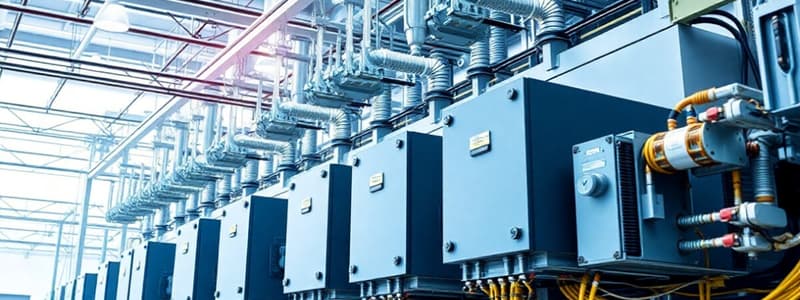Podcast
Questions and Answers
Which device is used in power systems to change voltage levels?
Which device is used in power systems to change voltage levels?
- Capacitor
- Inductor
- Transformer (correct)
- Resistor
What type of device acts as an electronic switch or amplifier?
What type of device acts as an electronic switch or amplifier?
- Transistor (correct)
- Capacitor
- Resistor
- Diode
Which tool is used to design and visualize electrical systems?
Which tool is used to design and visualize electrical systems?
- Multimeter
- Circuit Analysis Software
- Oscilloscope
- Computer-Aided Design (CAD) Software (correct)
Which application benefits from using microprocessors?
Which application benefits from using microprocessors?
Which component allows current to flow in only one direction?
Which component allows current to flow in only one direction?
Which of the following is NOT a core area of focus in electrical engineering?
Which of the following is NOT a core area of focus in electrical engineering?
What is the fundamental concept that deals with the flow of electric charges?
What is the fundamental concept that deals with the flow of electric charges?
In a series circuit, how are the components connected?
In a series circuit, how are the components connected?
Which area of electrical engineering focuses on the generation, transmission, and distribution of electrical power?
Which area of electrical engineering focuses on the generation, transmission, and distribution of electrical power?
What is the primary function of signal processing techniques?
What is the primary function of signal processing techniques?
Which of the following is NOT a key area of specialization within electrical engineering?
Which of the following is NOT a key area of specialization within electrical engineering?
What type of circuit is characterized by components being connected across a common voltage source?
What type of circuit is characterized by components being connected across a common voltage source?
Which of the following is a key concept in electrical engineering that describes the relationship between electricity and magnetism?
Which of the following is a key concept in electrical engineering that describes the relationship between electricity and magnetism?
Flashcards
Resistors
Resistors
Components that oppose the flow of electric current.
Capacitors
Capacitors
Components that store electric charge for later use.
Transistors
Transistors
Semiconductor devices that act as electronic switches or amplifiers.
Microcontrollers
Microcontrollers
Signup and view all the flashcards
Transformers
Transformers
Signup and view all the flashcards
Electrical Engineering
Electrical Engineering
Signup and view all the flashcards
Electricity
Electricity
Signup and view all the flashcards
Electronics
Electronics
Signup and view all the flashcards
Electromagnetism
Electromagnetism
Signup and view all the flashcards
Circuits
Circuits
Signup and view all the flashcards
Signal Processing
Signal Processing
Signup and view all the flashcards
Power Systems Engineering
Power Systems Engineering
Signup and view all the flashcards
Control Systems Engineering
Control Systems Engineering
Signup and view all the flashcards
Study Notes
Introduction to Electrical Engineering
- Electrical engineering is a broad field encompassing the study and application of electricity, electronics, and electromagnetism.
- It involves designing, developing, testing, and maintaining electrical systems and devices.
- Core areas of focus include power systems, control systems, signal processing, telecommunications, and computer engineering.
- Electrical engineers work on a wide range of projects, from household appliances to complex industrial equipment, and from communication networks to large-scale power grids.
Core Concepts in Electrical Engineering
- Electricity: The fundamental concept deals with the flow of electric charges.
- Electronics: Deals with the control and manipulation of current flow at the microscopic level using electronic components like transistors and diodes.
- Electromagnetism: Describes the relationship between electricity and magnetism, and how they can be used to generate and manipulate energy.
- Circuits: Networks of electrical components interconnected to perform specific functions.
- Series circuits: Components are connected end-to-end.
- Parallel circuits: Components are connected across a common voltage source.
- Signal Processing: Techniques used to analyze, modify, and extract information from signals.
- Power Systems: Generation, transmission, and distribution of electrical power.
Key Areas of Specialization
- Power Systems Engineering: Designing and maintaining power generation, transmission, and distribution systems, encompassing renewable energy integration.
- Control Systems Engineering: Design and implementation of systems that control the behavior of physical processes, often utilizing feedback mechanisms.
- Electronics and Communications Engineering: Designing and developing electronic circuits and communication systems.
- Computer Engineering: Focuses on the design and implementation of computer hardware and systems, often intertwined with electrical engineering principles.
- Signal Processing: Specialized in the development of techniques for extracting useful information from signals, employed extensively in imaging, audio, radar, and telecommunications.
- Instrumentation and Measurement: Developing devices to acquire, process, and present measurement data, utilized in diverse applications.
- Renewable Energy Engineering: Growing area focused on efficient and sustainable energy sources.
Components and Devices
- Resistors: Components that oppose the flow of current.
- Capacitors: Components that store electric charge.
- Inductors: Components that store energy in a magnetic field.
- Transistors: Semiconductor devices that act as electronic switches or amplifiers.
- Diodes: Components that allow current to flow in one direction.
- Transformers: Used in power systems to change voltage levels.
Tools and Technologies
- Circuit Analysis Software: Used to model and simulate electrical circuits.
- Measurement Instruments: Examples include oscilloscopes and multimeters.
- Computer-Aided Design (CAD) Software: Used to design and visualize electrical systems.
- Digital Logic Design: Basis for modern computer systems.
- Microcontrollers: Small, self-contained integrated circuits that control systems and applications.
- Microprocessors: Central processing units (CPUs) in digital devices.
Applications of Electrical Engineering
- Consumer Electronics: Computers, smartphones, televisions, appliances.
- Communication Systems: Telephones, radios, television broadcasting, internet.
- Power Systems: Power grids, generators, transformers.
- Automotive Systems: Electric and hybrid vehicles, advanced driver-assistance systems.
- Industrial Automation: Controlling machinery and processes in factories.
- Medical Devices: Diagnostic tools, life support systems.
Studying That Suits You
Use AI to generate personalized quizzes and flashcards to suit your learning preferences.




